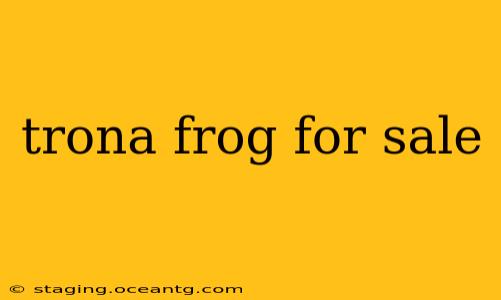Finding a Trona Frog: A Guide for Potential Owners
The Trona Pinnacles, located in California's Searles Lake, are famous for their unique geological formations and the surprisingly diverse wildlife they support. While not officially "for sale," the Trona Pinnacles themselves are a protected area, and the animals inhabiting them, including the diverse frog population, are part of a delicate ecosystem. This guide explores what it might mean to want to "own" a Trona frog and the responsible alternatives.
What kind of frog is found near the Trona Pinnacles?
The Trona Pinnacles region isn't known for a specific frog species named the "Trona frog." Instead, various amphibian species likely inhabit the area, depending on the presence of water sources and suitable habitats. Identifying a specific frog species found around the Trona Pinnacles would require detailed ecological surveys of the area. It's crucial to understand that many amphibian populations are sensitive to disturbance and habitat loss.
Can I legally buy a frog from the Trona Pinnacles area?
No. Collecting wildlife, including frogs, from protected areas like the Trona Pinnacles is illegal without the proper permits and licenses, which are rarely granted for personal ownership. Removing animals from their natural habitat disrupts the ecosystem and can have severe consequences for the animal's survival. Furthermore, many frog species are protected under state and federal laws.
Are there ethical alternatives to buying a Trona frog?
Absolutely! Instead of seeking to purchase a wild frog, consider these ethical and responsible alternatives:
- Learn about the amphibians of the Mojave Desert: Research the amphibian species actually found in the region surrounding the Trona Pinnacles. This will satisfy your curiosity and provide a deeper appreciation for the area's biodiversity. Many online resources and field guides offer detailed information.
- Support conservation efforts: Donate to or volunteer with organizations dedicated to protecting the Mojave Desert's fragile ecosystem and its amphibian inhabitants. Your contributions can help ensure the long-term survival of these animals in their natural habitat.
- Observe amphibians in their natural habitat: Visit the Trona Pinnacles (respectfully and following all regulations) and enjoy observing the wildlife from a distance. Remember to leave no trace and minimize your impact on the environment.
- Keep native amphibians: Consider keeping ethically sourced native amphibians if you're truly interested in amphibian care, but only with extensive research and preparation. Only acquire animals from reputable breeders who prioritize animal welfare and are familiar with the specific needs of their species.
What are the challenges of keeping a wild-caught frog?
Keeping a wild-caught frog presents numerous challenges:
- Disease: Wild frogs can carry parasites and diseases that are difficult to treat.
- Dietary needs: Providing the correct diet for a wild frog can be complex and challenging.
- Stress: Capturing and transporting a frog causes significant stress, which can weaken its immune system and make it more susceptible to disease.
- Legal restrictions: As mentioned earlier, collecting wild frogs is often illegal.
What should I do if I find an injured frog near the Trona Pinnacles?
If you discover an injured frog, contact your local wildlife rehabilitation center. They have the expertise and resources to provide appropriate care. Never attempt to treat an injured animal yourself.
In conclusion, while the idea of "owning" a Trona frog might be tempting, ethical and legal considerations prohibit it. Respecting wildlife and its habitat is crucial for their survival and maintaining the health of our planet's ecosystems. Instead, focus on responsible appreciation, learning, and conservation efforts to support these amazing creatures.
